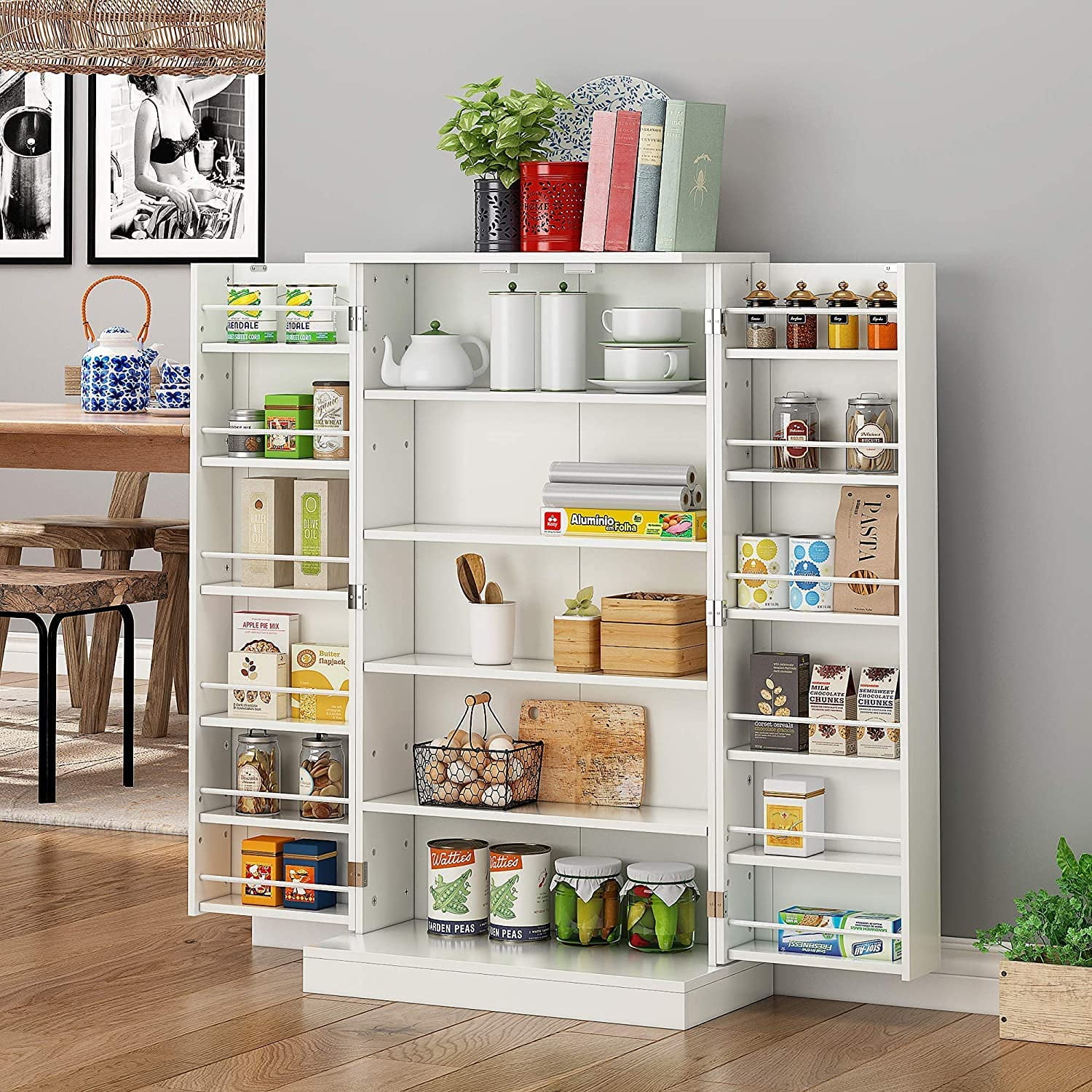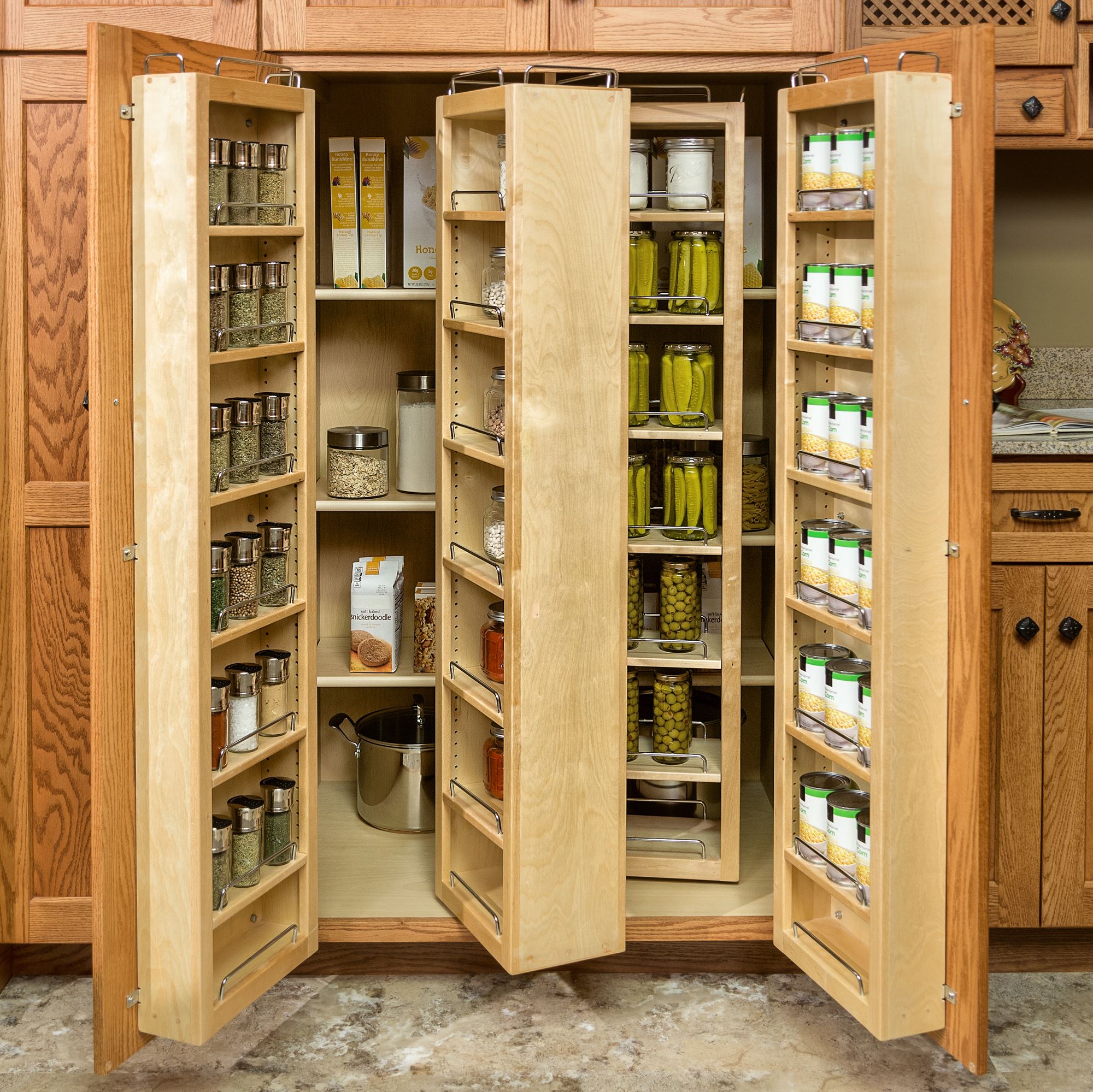The Appeal of Solid Wood Kitchen Pantry Cabinets

Solid wood kitchen pantry cabinets offer a timeless elegance and durability that sets them apart from other cabinet options. Their natural beauty and inherent strength make them a worthwhile investment for any homeowner seeking a high-quality, long-lasting storage solution.
Advantages of Solid Wood Construction
Solid wood construction offers several advantages over other materials, making it an excellent choice for kitchen pantry cabinets.
- Durability: Solid wood is inherently strong and resistant to wear and tear. Unlike particleboard or MDF, which can easily chip or dent, solid wood can withstand the rigors of everyday use. This durability ensures that your pantry cabinets will remain functional and attractive for years to come.
- Longevity: Well-crafted solid wood cabinets can last for generations, making them a truly sustainable investment. Unlike cabinets made from other materials, which may need to be replaced every few years, solid wood cabinets can be refinished and restored to their original beauty, extending their lifespan significantly.
- Aesthetic Appeal: Solid wood possesses a unique warmth and natural beauty that cannot be replicated by other materials. The intricate grain patterns and rich colors add character and sophistication to any kitchen. Solid wood cabinets can be stained or painted to match any décor, creating a truly personalized space.
Environmental Considerations
Choosing solid wood for your kitchen pantry cabinets is an environmentally conscious decision.
- Sustainable Forestry: When sourced from responsibly managed forests, solid wood is a renewable resource. Sustainable forestry practices ensure that trees are harvested at a rate that allows for natural regeneration, minimizing the environmental impact.
- Reduced Emissions: Solid wood is a natural material that does not require the same level of processing as other materials, such as particleboard or MDF. This reduced processing translates to lower emissions during manufacturing, contributing to a greener footprint.
- Biodegradability: Unlike synthetic materials, solid wood is biodegradable, meaning it can decompose naturally over time. This makes it a more environmentally friendly choice at the end of its life cycle.
Price Range
Solid wood kitchen pantry cabinets are generally more expensive than cabinets made from other materials. However, their durability and longevity make them a worthwhile investment in the long run.
- Price Comparison: Solid wood cabinets typically cost more than cabinets made from particleboard or MDF. However, their higher price tag is often offset by their superior durability and longevity, making them a more cost-effective choice over time.
- Factors Affecting Price: The price of solid wood cabinets can vary depending on the type of wood, the quality of construction, and the complexity of the design. High-end woods like cherry or walnut will naturally command a higher price than more affordable options like oak or maple.
Common Wood Species, Solid wood large unfinished kitchen pantry cabinet
Several wood species are commonly used for kitchen pantry cabinets, each with its unique characteristics.
- Oak: Known for its durability, strength, and distinctive grain patterns, oak is a popular choice for kitchen cabinets. It is also relatively affordable, making it a good value for the money.
- Maple: Maple is a hard, dense wood with a smooth, fine grain. It is often used for kitchen cabinets because it is resistant to scratches and dents. Maple can be stained in a variety of colors, allowing for customization to match any décor.
- Cherry: Cherry wood is known for its rich, reddish-brown color and beautiful grain patterns. It is a relatively soft wood, making it easier to work with, but it can be more susceptible to scratches and dents. Cherry wood darkens over time, developing a warm patina that adds to its appeal.
- Walnut: Walnut is a luxurious wood with a distinctive dark brown color and striking grain patterns. It is known for its strength and durability, making it an excellent choice for kitchen cabinets. Walnut is a relatively expensive wood, but its beauty and longevity make it a worthwhile investment.
Design and Functionality

A large, unfinished kitchen pantry cabinet is a versatile and customizable storage solution that can transform your kitchen organization. These cabinets are designed to maximize storage space and offer a blank canvas for you to create a system that perfectly suits your needs.
Features and Functionalities
Unfinished kitchen pantry cabinets are typically constructed with sturdy, solid wood frames and doors, offering durability and a classic aesthetic. They often feature adjustable shelves, allowing you to customize the height of each shelf to accommodate different items, from tall jars to small boxes. Some models also include drawers, providing additional storage options for smaller items like utensils, spices, or baking supplies.
Different Configurations and Layouts
Pantry cabinets can be configured in various ways to optimize storage space and accommodate specific needs. Here are some common layouts:
- Standard Shelf Layout: This configuration features multiple shelves with adjustable heights, ideal for storing a variety of items, from canned goods to baking supplies.
- Shelves with Drawers: This layout combines shelves with drawers, providing both open and closed storage options. Drawers are perfect for storing smaller items, while shelves accommodate larger items.
- Pull-Out Shelves: These shelves are mounted on tracks and pull out for easy access to items stored in the back. This is a great option for maximizing storage space and making it easier to reach items.
- Spice Racks and Organizers: Many pantry cabinets include built-in spice racks or dedicated organizers for storing spices, oils, and other small items. These features keep your spices organized and easily accessible.
Storage Needs and Kitchen Layout
When designing a pantry cabinet, it’s crucial to consider your storage needs and kitchen layout. Here are some factors to consider:
- Available Space: Measure the available space in your kitchen to determine the size of the pantry cabinet that will fit comfortably.
- Storage Needs: Identify the types of items you need to store, such as canned goods, dry goods, snacks, baking supplies, and kitchen appliances.
- Accessibility: Consider the location of the pantry cabinet in your kitchen. Make sure it’s easily accessible and doesn’t obstruct traffic flow.
Benefits of Unfinished Wood
Unfinished wood offers a unique advantage for pantry cabinets. The unfinished surface allows you to personalize the cabinet to match your kitchen’s style and décor. You can choose to stain, paint, or leave the wood natural, depending on your preferences. This customization allows you to create a pantry cabinet that seamlessly blends with your existing kitchen design.
Installation and Finishing: Solid Wood Large Unfinished Kitchen Pantry Cabinet

Installing a large, unfinished kitchen pantry cabinet requires careful planning and execution. The process involves assembling the cabinet, securing it to the wall, and finishing the wood to achieve your desired aesthetic. This section will guide you through the installation process and explore various finishing options.
Tools and Materials
The tools and materials needed for installation and finishing depend on the specific cabinet and your chosen finishing method. Here’s a comprehensive list of essentials:
- Tools: Level, tape measure, stud finder, drill, screwdriver, saw, hammer, safety glasses, work gloves, and a paintbrush or roller.
- Materials: Cabinet hardware (hinges, knobs, pulls), screws, wood glue, wood filler, sandpaper (various grits), primer, paint or stain, varnish or sealant, drop cloths, and a respirator.
Installation Steps
Follow these steps to install your large, unfinished kitchen pantry cabinet:
- Prepare the Area: Clear the space where the cabinet will be installed. Remove any obstacles and ensure the floor is level.
- Determine Cabinet Placement: Measure the space and decide where the cabinet will fit best. Use a level to ensure the cabinet is placed straight.
- Locate Studs: Use a stud finder to locate wall studs for support. Mark the stud locations on the wall with a pencil.
- Assemble the Cabinet: If the cabinet comes in multiple pieces, assemble it according to the manufacturer’s instructions. Use wood glue and screws for a secure connection.
- Attach the Cabinet to the Wall: Use screws to attach the cabinet to the wall studs. Make sure the screws are long enough to reach into the studs for secure support.
- Install Hardware: Install the cabinet hardware, such as hinges, knobs, and pulls, following the manufacturer’s instructions.
Finishing Options
Unfinished wood provides a blank canvas for personalization. Here are popular finishing options:
- Staining: Staining enhances the natural grain of the wood and adds color. It comes in a variety of colors and finishes, from light washes to deep, rich tones. Choose a stain that complements your kitchen’s style and existing decor.
- Painting: Painting allows you to create a solid color, covering the wood’s natural grain. You can choose from a wide range of colors to match your kitchen’s theme.
- Varnishing: Varnish provides a protective coating that enhances the wood’s natural beauty and protects it from scratches, spills, and moisture. Varnishes come in different finishes, including gloss, satin, and matte.
Achieving a Professional Finish
To achieve a professional-looking finish on your solid wood pantry cabinet, follow these tips:
- Sanding: Sand the wood surface smoothly using sandpaper of various grits, starting with a coarse grit and progressing to a fine grit. This will create a uniform surface for staining, painting, or varnishing.
- Priming: Apply a primer to the wood surface before staining or painting. This helps to create a smooth, even surface for the finish and improves adhesion.
- Applying Stain or Paint: Apply the stain or paint in thin, even coats, following the manufacturer’s instructions. Allow each coat to dry completely before applying the next.
- Varnishing: Apply varnish in thin, even coats, allowing each coat to dry completely before applying the next. For a durable finish, apply multiple coats.
A solid wood large unfinished kitchen pantry cabinet is a blank canvas for your creativity, allowing you to personalize it with your own unique touch. Just like adding a statement rug can transform a bedroom into a haven of comfort and style, cool rugs for bedroom , a well-crafted cabinet can become the heart of your kitchen, adding warmth and character to the space.
So, take your time, choose your finishes, and let your imagination flow, creating a pantry cabinet that speaks to your heart.
A solid wood large unfinished kitchen pantry cabinet is a timeless investment, adding both functionality and character to your space. Imagine it in an open concept one bedroom apartment , where it can seamlessly blend into the design while providing ample storage for your culinary needs.
This cabinet allows you to personalize it with your choice of stain or paint, creating a unique piece that reflects your style and complements the overall aesthetic of your apartment.